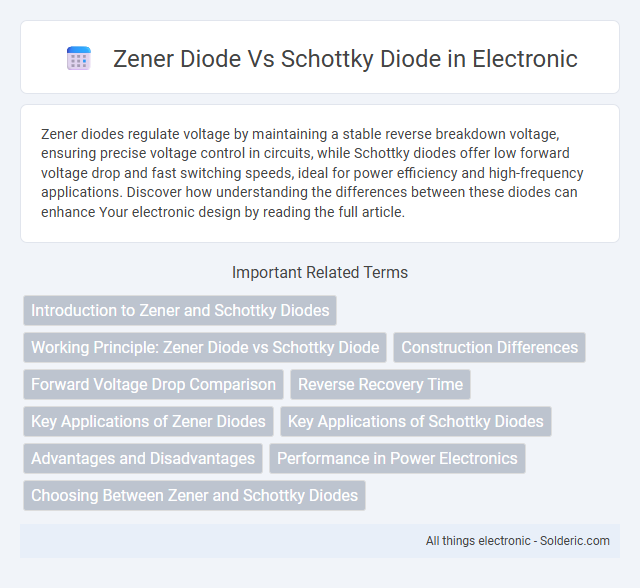Zener diodes regulate voltage by maintaining a stable reverse breakdown voltage, ensuring precise voltage control in circuits, while Schottky diodes offer low forward voltage drop and fast switching speeds, ideal for power efficiency and high-frequency applications. Discover how understanding the differences between these diodes can enhance Your electronic design by reading the full article.
Comparison Table
| Feature | Zener Diode | Schottky Diode |
|---|---|---|
| Primary Function | Voltage regulation | Fast switching, low forward voltage drop |
| Forward Voltage Drop | Approximately 0.7 V | Approximately 0.2 - 0.3 V |
| Reverse Breakdown Voltage | Defined Zener voltage (typically 2.4V to 200V) | Low, typically 20V to 100V |
| Switching Speed | Slower switching speed | Very fast switching speed |
| Construction | PN junction diode with heavily doped Zener region | Metal-semiconductor junction |
| Applications | Voltage clamping, voltage regulation, surge protection | Power rectification, RF applications, low voltage drop rectifiers |
| Reverse Leakage Current | Low leakage current | Higher leakage current compared to Zener diode |
Introduction to Zener and Schottky Diodes
Zener diodes regulate voltage by operating in reverse breakdown, ensuring stable voltage levels in circuits, while Schottky diodes provide low forward voltage drop and fast switching speed ideal for high-frequency applications. Your choice between these diodes depends on whether voltage regulation or efficient rectification is required. Understanding their distinct electrical characteristics optimizes circuit performance in power management and signal processing tasks.
Working Principle: Zener Diode vs Schottky Diode
Zener diodes operate by allowing current to flow in the reverse direction when the voltage exceeds a specific breakdown voltage, providing voltage regulation and protection in circuits. Schottky diodes use a metal-semiconductor junction, enabling faster switching speeds and lower forward voltage drop compared to conventional p-n junction diodes. Understanding the working principle of each diode helps you select the right component based on voltage regulation needs or high-speed switching applications.
Construction Differences
Zener diodes are constructed with a heavily doped p-n junction designed to allow breakdown at a precise reverse voltage, enabling voltage regulation. Schottky diodes utilize a metal-semiconductor junction, typically between metal and n-type semiconductor, resulting in lower forward voltage drop and faster switching speeds. Your choice depends on whether you prioritize voltage stabilization with Zener diodes or high-speed, low-loss rectification offered by Schottky diodes.
Forward Voltage Drop Comparison
Zener diodes typically have a higher forward voltage drop, around 0.7V, compared to Schottky diodes, which exhibit a lower forward voltage drop ranging from 0.15V to 0.45V. This lower forward voltage drop in Schottky diodes results in higher efficiency and reduced heat generation in power-sensitive applications. Understanding this difference allows you to select the appropriate diode type for voltage regulation or fast-switching circuits.
Reverse Recovery Time
Zener diodes typically exhibit a longer reverse recovery time compared to Schottky diodes, impacting their switching speed in high-frequency applications. Schottky diodes have a very fast reverse recovery time due to their majority carrier conduction, making them ideal for fast switching and low-loss rectification. Understanding the reverse recovery time differences helps you choose the appropriate diode for efficient circuit performance.
Key Applications of Zener Diodes
Zener diodes are primarily used for voltage regulation in power supplies, providing stable reference voltages in electronic circuits. They are essential for protecting sensitive components by clamping voltage spikes in surge protection and voltage clipping applications. Additionally, Zener diodes serve critical roles in waveform shaping and voltage switching within signal processing devices.
Key Applications of Schottky Diodes
Schottky diodes are widely used in power rectification, voltage clamping, and high-frequency circuits due to their low forward voltage drop and fast switching speed. They dominate in applications such as power supply rectifiers, RF mixers, and voltage clamping in transistors to prevent damage from voltage spikes. Their efficient performance in high-speed switching and low power loss makes them ideal for solar cell systems, switching power supplies, and radio frequency communication devices.
Advantages and Disadvantages
Zener diodes offer precise voltage regulation with a sharp breakdown voltage, making them ideal for voltage reference applications but suffer from slower switching speeds and higher noise compared to Schottky diodes. Schottky diodes provide fast switching speeds and low forward voltage drop, enhancing efficiency in high-frequency and low-voltage circuits; however, their reverse breakdown voltage is typically lower, limiting their use in high-voltage applications. The choice depends on whether voltage precision or switching performance is more critical for the circuit design.
Performance in Power Electronics
Zener diodes excel in voltage regulation by maintaining a stable reference voltage in power electronics circuits, effectively protecting sensitive components from voltage spikes. Schottky diodes offer superior performance in high-speed switching applications due to their low forward voltage drop and minimal reverse recovery time, enhancing efficiency in power converters. Your selection between the two should consider the specific needs for voltage stability versus switching speed and power loss reduction.
Choosing Between Zener and Schottky Diodes
Choosing between Zener and Schottky diodes depends on the application requirements such as voltage regulation versus fast switching and low forward voltage drop. Zener diodes are ideal for voltage regulation and voltage reference applications due to their precise breakdown voltage characteristics. Schottky diodes offer high-speed switching and low forward voltage, making them suitable for power rectification and RF applications.
Zener diode vs Schottky diode Infographic

 solderic.com
solderic.com